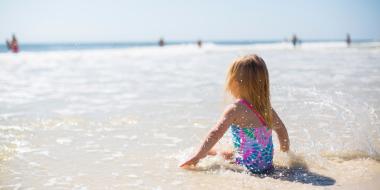If you don’t have a natural area adjacent to your backyard or aren’t comfortable sending your child off to play there unsupervised, the next best thing is a ‘natural’ playground. This growing trend in play structures uses natural materials and shapes to create a landscape that allows for creative use on the part of the child. Elements in a natural playground may include things like mounds of earth, vegetation, boulders, log structures, stumps, dirt or sand areas, natural water features, tree houses, and large musical instruments. They are meant to challenge children and ignite their imaginations. They are popping up in parks and schoolyards across the continent.
The unstructured natural play that was once inherent in childhood is becoming scarce as children spend more and more time in front of screens (according to Common Sense Media, kids between 0 and 8 years old spend 2 1/3 hours on media, and 8 to 12-year-olds spend 6 hours a day on screen time!) and in organized activities. With so much structure and programming in their lives today, children benefit from being allowed free range play, without prescribed direction, to explore and engage all of their senses. A miniature metal car in a conventional playground only serves one purpose and engages children for a shorter time frame. In a play environment composed of natural materials, a log can become a balance beam, a horse, a car, or a surfboard (to name a few).

Photo courtesy Bienenstock Natural Playgrounds

Photo courtesy Bienenstock Natural Playgrounds
Canadian safety standards (CSA) are of course met in all of these natural playgrounds and in fact they inherently have less risk for injury than conventional playgrounds because of lower fall heights but they also offer a child great opportunities for learning essential risk management skills. The graduated challenges in a natural environment help children understand, evaluate and judge risk on their own while learning (and pushing) their own physical limitations and abilities and practicing personal responsibility – all important stages of development. In a natural playground, less adult intervention is required because of the lack of high structures and children are thus allowed to delve into their imaginary worlds with greater abandon. Letting kids play with less supervision helps them develop problem-solving skills, social skills, co-operation, creative ambition and, importantly, imagination.
Bienenstock's Guiding Principles
Bienenstock Natural Playgrounds has developed a set of 10 principles that guide their natural park and playground projects:
- You will hear laughter.
- Play is unstructured, self directed, and creative, not prescriptive.
- Play is built on a backbone of real, raw, nature.
- Bugs, birds, dirt, hills, rocks, water, and trees are the good stuff.
- Bumps, bruises and scrapes are celebrated.
- There are four seasons, we play in all of them.
- We must all be compelled to move.
- We will engage all of our senses.
- We must create obstacles, increase risk, and decrease hazards.
- Size matters; we all deserve to feel small next to an ancient tree or huge next to a challenge.
The arguably uninspiring play structures that have taken over parks across the country since I was a child cater mainly to younger children and gross motor skill development. Think about the balance required to walk across a log compared to that needed to walk across a smooth even surface. Or the skill needed to climb a tree with varying heights and widths of branches versus monkey bars where each rung is the same distance from the last and the same width and height as all the others. Which of these will develop the best gross and fine motor skills, core strength and agility? Natural playscapes engage a broad range of ages and abilities by creating space for various forms of physical play but also spaces for contemplation and creative play. They are more inclusive places for children with accessibility challenges, including autism spectrum disorder and sensory loss.

Photo courtesy of Bienenstock Natural Playgrounds

Photo courtesy of Bienenstock Natural Playgrounds
Does a natural playground replace the need to get kids out into wild spaces? Not at all, but it is a contained, safe alternative in urbanized and even rural areas. It can provide some of the same lessons learned in the woods while meeting safety standards and assuaging the fear of litigation that seems to direct the decisions of municipalities and school boards across the continent these days.
Some North American playground companies that focus on natural playscapes:






